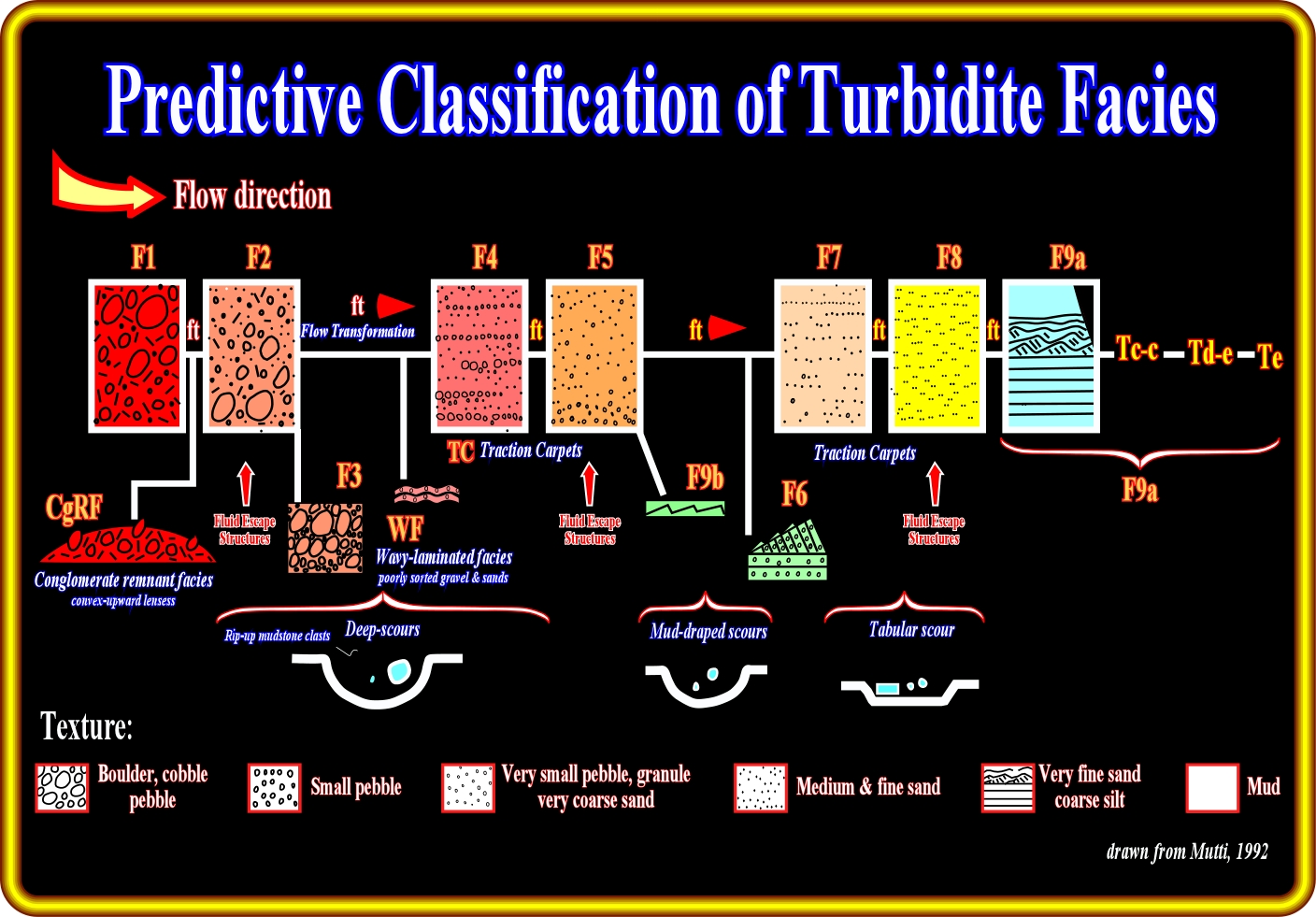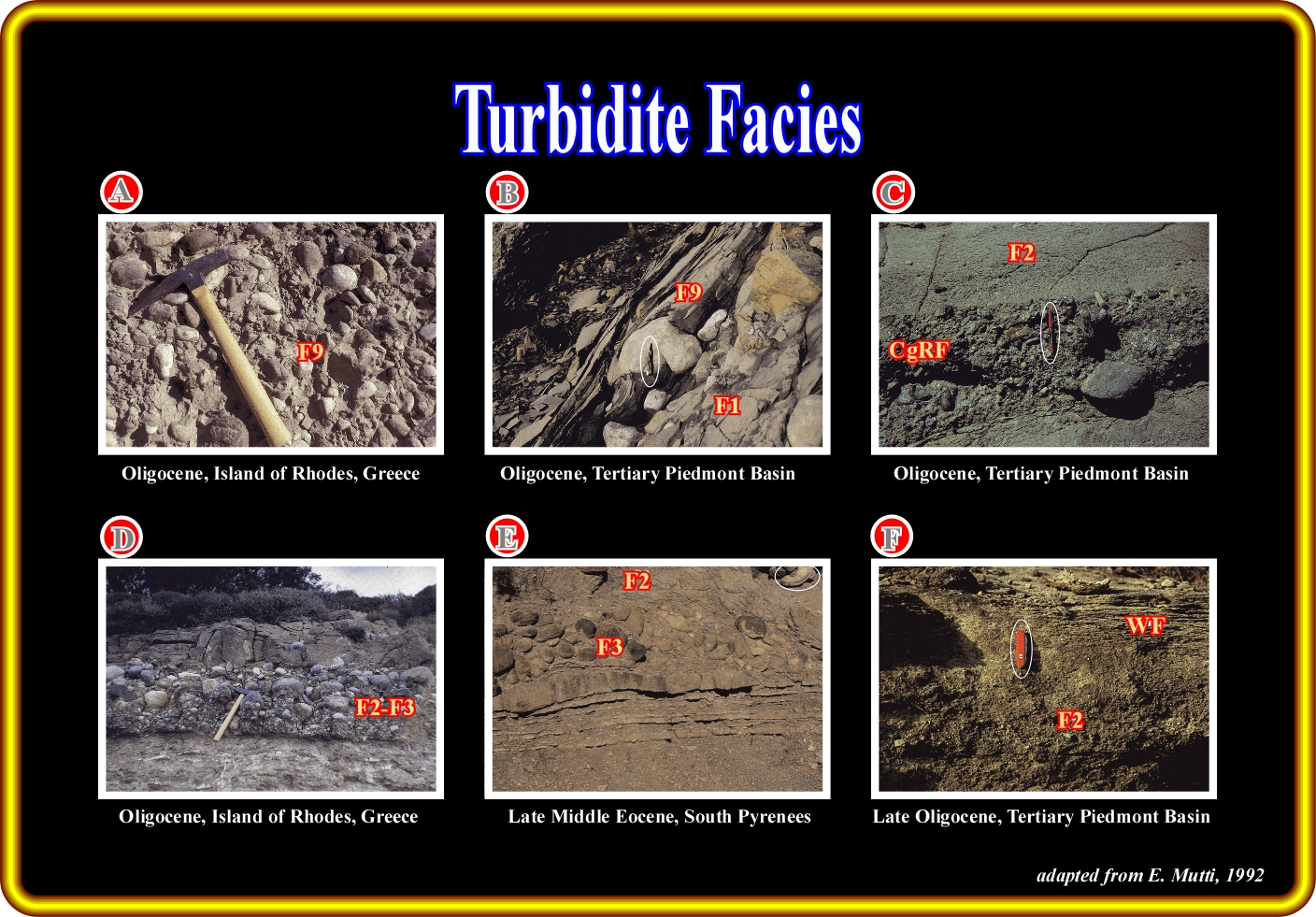
Facies tracts can only be significantly reconstructed within a framework for predictive facies classification scheme that relates facies and processes, i.e., through second or genetic level of facies analysis. Such a framework, proposed by Mutti (1977, 1992), is illustrated below and covers a very broad spectrum of facies from cohesive debris flow deposits (F1), with boulder-, cobble-, and pebble-sized clasts, to graded mudstones (Te of F9a).

Four kinds of flow transformations were recognized by Mutti (1977 & 1992) : (i) Body transformation occurs when the flow changes between laminar and turbulent within the body of a flow without significant addition or loss of interstitial fluid ; (ii) Gravity transformation occurs when initially turbulent, particle-charged flows become gravitationally segregated and develop a high concentration, laminar underflow with an overriding more dilute turbulent flow ; (iii) Surface transformation occurs when ambient fluid becomes mixed or lost at flow boundaries by drag over separation into laminar and turbulent flow ; (iv) Elutriation transformation develops by elutriation (process for separating particles based on their size, shape and density, using a stream of gas or liquid flowing in a direction usually opposite to the direction of sedimentation or a purification, or removal of material from a mixture or in suspension in water, by washing and decanting, leaving the heavier particles behind)) of the particles by upward-moving fluids from a high-concentration flow to produce a turbulent dilute-phase above the base of the flow.
Direct field evidence shows that cohesive debris flows, hyperconcentrated flows and gravelly, high-density turbidity currents produce facies types, which are clearly genetically inter-related. The main facies types can be subdivided into three main groups:
A) Very Coarse Grained Facies ;
B) Coarse Grained Facies ;
C) Fine Grained Facies.

In cohesive debris flows, clasts are supported by matrix strength and density and deposition takes place when the applied shear can no longer overcome the flow strength. Sediments of this type, which result from cohesive freezing, are easily recognized since they consist of mud- supported clast. In high-density turbidity currents, either gravelly or sandy, clasts are supported within the flow by several mechanisms, which are inherent to sediment concentration and in which result in hindered settling of coarse particles. The sediments of these flows typically consist of thick-bedded and coarse-grained sandstone and pebbly sandstone facies. Low-density turbidity currents characteristically maintain their fine-grained sediment load within the flow through turbulence and deposit it through a very distinctive process of traction-plus-fallout. Beds in which thoroughly current-laminated fine-grained sandstone and coarse siltstone grade upward into a massive mudstone unit commonly represent these sediments.
1) Very Coarse Grained Facies
Three main facies can often be distinguished :
F1 deposits are the product of cohesive debris flows. The following features characterize them :
- The lack of significant basal scours ;
- The larger clasts floating in a matrix, which relative to F2 deposits of the same facies tract, is muddier and may show features related to plastic flow ;
- The tendency for the largest clasts to concentrate toward the top of the bed and project upward above the top of the bed.
F2 deposits are considered as the product of hyperconcentrated flows resulting from the downslope transformation of cohesive flow through progressive mixing with ambient fluid. F2 deposits are extremely common in many coarse-grained turbidite systems. Relatively to the F1, the following features characterize them :
- Occurrence of deep basal scours and large rip-up mudstone clasts ;
- The larger clasts float in a fully mixed and occasionally crudely graded matrix composed of mud, sand and gravel ;
- The largest clasts show a clear tendency to occur in the lower part of the bed.
F3 deposits consist of clast-supported conglomerates forming beds and bedsets commonly bounded by basal erosional surfaces. The internal organization of this facies is variable and is most commonly represented by an unstratified and generally inversely graded deposit. This organization strictly depends on the shear stress imparted on these gravel layers from the overlying residual flow.
2) Coarse Grained Facies
This group includes, in a downcurrent direction, WF, F4, F5, and F6 sediments, which are interpreted as products of gravelly, high-density turbidity currents and of the transformations which take place from the origin to the end of these flows :
- WF sediments consist of relatively thin divisions, usually between 5-20 cm thick, of very poorly sorted very coarse sand and small gravel beds displaying a faint wavy lamination. Wavelength is generally less than 50 cm and individual laminae have a thickness up to 1cm. These sediments have been tentatively interpreted as an upper flow regime, which forms at the transformation of a hyperconcentrated flow into a fluidal, high-density, and supercritical turbidity current ;
- F4 and F5 deposits are the most common sediments found within this group of facies. Relatively thick and coarse-grained traction carpets characterize F4 deposits ;
- F5 deposits are devoid of internal stratification and fluid escape features can be very common. Unless the original parent flow already consisted of relatively well-sorted sediment, F5 beds are characteristically poorly sorted compared with to F8 deposits ;
- Coarse-grained and internally stratified deposits represent F6 sediments. These beds are generally relatively well sorted and characterized by the common lack of grading. These sediments are considered as a product of a hydraulic jump that transforms a supercritical high-density turbidity current into a subcritical, low-density one.
3) Fine Grained Facies
This group includes F7, F8 and F9 deposits, i.e., those sediments that are considered as the product of low-density, sub critical turbidite currents (figs. 29 and 30). These currents begin their deposition after either a hydraulic jump (F6) or a gravity transformation through which an F5 deposit is overlain or replaced in a down current direction by an F7 deposit. The end of the deposition is reached where the mud-size suspended load can settle through a quasi-static flow. These fine-grained facies are generally considered the best-known turbidite sediments since they include the classic Bouma sequence and the classic turbidite of Walker.
- F7 deposits are common in many turbidite systems and are characterized by thin and relatively coarse-grained, horizontal laminae that can be easily mistaken for the traction carpets of F4 deposits or the b Bouma division of F9 beds.
- F8 sediments are considered as the true division a of the Bouma sequence and consist of structureless, medium to fine sand. Grading may or may not be present. Within the same facies tract, an F8 division is always finer grained and considerably better sorted than an F5 deposit, thus permitting an easy distinction between the two facies types.
- F9 deposits are made up of thoroughly current-laminated divisions of very fine sand and coarse siltstone which are capped by a massive mudstone division, These sediments, which are commonly referred to in most literature as “base-missing” Bouma sequences (Tb-e, Tc-e, Td-e and Te sequences), constitute the volumetrically most important component of many ancient turbidite basin-fills. F9 strata can be simply defined as turbidite beds, which have been deposited by traction-plus-fallout processes, associated with the various stages of sedimentation of waning low-density turbidity currents.

(A) Thick pebbly mudstone (F1) containing out-size blocks of a slump-folded sandstone in its upper part (no shown in photograph). These blocks were transported within a "rigid plug" of cohesive debris flow, i.e., where the applied shears stress cannot overcome the internal strength of the flow. B) Laminated sandstone (F9 deposit) onlaps onto and drapes a large clast of F1 deposit. C) Abrupt and probably erosional contact between the CgRF and the overlying F2 deposit. The CgRF is interpreted as the result of a surface transformation of a cohesive debris flow whose upper part has been transformation into a hyperconcentrated flow. D) Basal inverted graded and very poorly sorted clast- to sand. supported cobble and pebble conglomerate overlain by a structureless sandstone containing floating cobbles and pebbles at different levels. This bed is interpreted as the result of both frictional and cohesive freezing that occurred during gravity transformation within an hyperconcentrated flow. The bed is therefore classified as an intermediate deposit between F2 and F3. E) Gravity transformation of a hyperconcentrated flow has produced a basal F3 deposit overlain by a F2 division. Note the abrupt wedging of the F3 deposit toward the right, i.e. in an upcurrent direction. F) Poorly shorted and crudely graded sandstone (F2) overlain by a WF facies. The latter consists of irregular undulating laminae of coarse-grained sandstone with scattered small pebbles. The facies is thought to record a surface transformation from an underlying hyperconcentrated flow into a supercritical fluidal flow.

A) Bed showing a very abrupt facies change between F3 and F4 divisions. On the right, the basal part of the F3 division includes abundant rip-up mudstone clasts. A thin , F9 division forms the top of the bed, draping both F4 and F3 deposits. B) Water-escape feature (arrow) developed in F9 laminae overlying a F5 division. Younging direction (the direction in which a series of inclined sedimentary rocks becomes younger)is to the left. C) F5 division abruptly overlain, through a break in grain size, by a thin F9 division. The latter is interpreted as the deposit of the dilute "tail" of the flow. D) From base to top, the bed consists of a basal F5 division abruptly overlain by an F6 deposit with cross stratification. The F6 division is sharply overlain by an F9a deposit showing ripple and convolute lamination. Both sharp contacts (arrows) are thought to record sediment bypass. E) Two amalgamated sandstone beds (arrows indicates the amalgamation surface). The upper bed consists of a lower division made up of very coarse-grained and cross stratified sandstone (F6) overlain, through a sharp break in grain size, by and F8 division composed of medium-to fine-grained structureless sandstone. F) Composite sandstone bed characterized by a basal, poorly sorted F5 division overlain by an F7 deposit with thin to very thin traction carpets. Note the lack of an F6 deposit between the two facies and the fairly distinct break in grain size between F5 and F7 divisions.